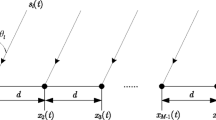Abstract
This paper presents a low-complexity MUSIC-like algorithm with sparse linear array. Three uniform linear arrays are combined into a sparse linear array. An extended signal subspace is got by organizing the forth-order-cumulant of array received data. During this process, no eigen-value decomposition (EVD) or singular-value decomposition needs to be implemented. Then, a MUSIC-like method is proposed to estimate the direction-of-arrival of incident signals. In order to bring down the computational complexity further, an ESPRIT-like algorithm is used to obtain the initial estimations of direction angles, by which the search range can be diminished significantly. Compared with the classical MUSIC and PM, the proposed MUSIC-like algorithm shows better angular resolution and higher estimation accuracy. Moreover, because of the avoidance of EVD and the reduction of search range, the computational burden of the proposed MUSIC-like algorithm with per-estimation by ESPRIT-like algorithm is small. The performance of the proposed method is demonstrated through numerical simulations.









Similar content being viewed by others
References
Zhang, X., Gao, X., Feng, G., & Xu, D. (2009). Blind joint DOA and DOD estimation and identifiability results for MIMO radar with different transmit receive array manifolds. Progress in Electromagnetics Research B, 18, 101–119.
Stoica, P., & Selen, Y. (2004). Model-order selection: a review of information criterion rules. IEEE Signal Processing Magazine, 21(4), 6–47.
Huang, X., Guo, Y. J., & Bunton, J. D. (2010). A hybrid adaptive antenna array. IEEE Trans. Wireless Communication, 9(5), 1770–1779.
Schmidt, R. O. (1986). Multiple emitter location and signal parameter estimation. IEEE Transactions on Antennas and Propagation, 34(3), 276–280.
Roy, R., & Kailath, T. (1986). Estimation of signal parameters via rotational invariance techniques. IEEE Transactions on ASSP, 37(7), 984–995.
Ottersten, B., Viberg, M., & Kailath, T. (1991). Performance analysis of the total least squares ESPRIT algorithm. IEEE Transactions on Signal Processing, 39(5), 1122–1135.
Marcos, S., Marsal, A., & Benidir, M. (1995). The propagator method for source bearing estimation. Signal Processing, 42(2), 121–138.
Chen, H., & Zhang, X. F. (2013). Two-dimensional DOA estimation of coherent sources for acoustic vector-sensor array using a single snapshot. Wireless Personal Communication, 72, 1–13.
Stoica, P., & Nehorai, A. (1989). MUSIC, maximum likelihood and Cramer–Rao bound. IEEE Transactions on Acoustics, Speech, and Signal Processing, 37(5), 720–741.
Yang, P., Liu, Z., & Jiang, W. L. (2014). Improved sparse Bayesian learning method for direction-of-arrival estimation in non-uniform noise. Journal of Electromagnetic Waves and Applications., 28(5), 563–573.
Zhang, Y., Ye, Z. F., Xu, X., & Hu, N. (2014). Off-grid DOA estimation using array covariance matrix and block-sparse Bayesian learning. Signal Processing, 98, 197–201.
Yang, Z., Xie, L. H., & Zhang, C. S. (2014). Off-grid direction of arrival estimation using sparse Bayesian Inference. IEEE Transactions on Signal Processing, 61(1), 38–43.
Chen, C., Lorenzelli, F., Ralph Hudson, K., & Yao, E. (2008). Stochastic maximum-likelihood DOA estimation in the presence of unknown nonuniform noise. IEEE Transactions on Signal Processing, 56(7), 3038–3044.
Ma, W. K., Hsieh, T. H., & Chi, C. Y. (2010). DOA estimation of quasi-stationary signals with less sensors than sources and unknown spatial noise covariance: A Khatri–Rao subspace approach”. IEEE Transactions on Signal Processing, 58(4), 2168–2180.
Pal, P., & Vaidyanathan, P. P. (2012). Multiple level nested array: anefficient geometry for 2qth order cumulant based array processing. IEEE Transactions on Signal Processing, 60(3), 1253–1269.
Pal, P., & Vaidyanathan, P. P. (2010). Nested arrays: A novel approach to array processing with enhanced degrees of freedom”. IEEE Transactions on Signal Processing, 58(8), 4167–4181.
Hu, N., Ye, Z. F., Xu, X., & Bao, M. (2013). DOA estimation for sparse array via sparse signal reconstruction. IEEE Transactions on Aeronautics and Electronic Systems, 49(2), 760–773.
Liu, Z. T., Ruan, X. Y., & He, J. (2013). Efficient 2-D DOA estimation for coherent sources with a sparse acoustic vector-sensor array. Multidimensional Systems and Signal Processing, 24, 105–120.
Wong, K. T., & Zoltowski, M. D. (2000). Self-initiating MUSIC-based direction finding in underwater acoustic particle velocity-field beamspace. IEEE Journal of Oceanic Engineering, 25(2), 262–273.
Vaidyanathan, P. P., & Pal, P. (2011). Sparse sensing with co-prime samplers and arrays. IEEE Transactions on Signal Processing, 59(2), 573–586.
Weng, Z. Y., & Petar, M. D. (2014). A search-free DOA estimation algorithm for coprime arrays. Digital Signal Processing, 24, 27–33.
Liang, G. L., & Han, B. (2014). Near-field sources localization based on co-prime symmetric array. Journal of and Information Technology, 36(1), 135–139.
Liu, S., Yang, L. S., Wu, D. C., & Huang., J. H. (2014). Two-dimensional DOA estimation using a co-prime symmetric cross array. Progress in Electromagnetics Research C, 54, 67–74.
Acknowledgments
This work was supported by the National Natural Science Foundation of China (Nos. 61301120, 51377179), the Fundamental Research Funds for the Central Universities of CQU (CDJPY12160001), and the Natural Science Foundation Project of CQ CSTC (CSTC2011GGYS0001).
Author information
Authors and Affiliations
Corresponding author
Rights and permissions
About this article
Cite this article
Liu, S., Yang, L., Chen, Z. et al. Low-Complexity MUSIC-Like Algorithm with Sparse Array. Wireless Pers Commun 86, 1265–1279 (2016). https://doi.org/10.1007/s11277-015-2987-9
Published:
Issue Date:
DOI: https://doi.org/10.1007/s11277-015-2987-9




